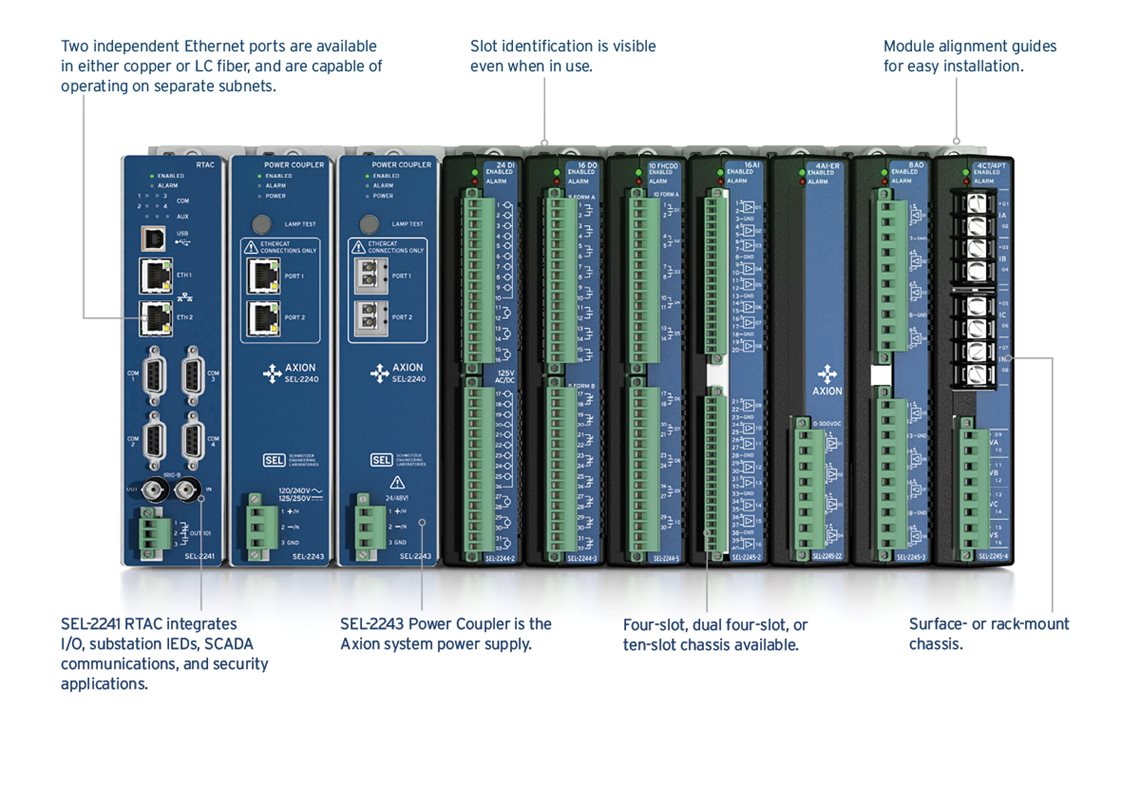The SEL-2240 Axion is a fully integrated, modular input/output (I/O) and control solution ideally suited for utility and industrial applications. It combines the communications, built-in security, and IEC 61131 logic engine of the SEL Real-Time Automation Controller (RTAC) family with a durable suite of I/O modules that provide high-speed, deterministic control performance over an EtherCAT network.
Whether your application calls for a remote terminal unit (RTU) or an ultrarugged programmable logic controller (PLC), the SEL-2240 will be a good match. All of the SEL Axion modules are rated from –40° to +85°C and can optionally include conformal coating. The system is designed to be flexible; use the right combination of modules and nodes in almost any arrangement to suit the job. The SEL-2244-3 Digital Output Module has substation duty contacts (30 A make, 6 A carry) in order to provide reliable operation and flexible application.
The SEL-3530, SEL-3530-4, SEL-3555 RTACs, and SEL-2241 RTAC Module can all operate as the CPU for an SEL Axion Platform. They interface seamlessly with the I/O modules and provide easy integration with other serial and Ethernet devices via preinstalled communications protocols. The RTACs also support multiple SCADA/HMI channels. For high-speed communication, use EtherCAT fieldbus connections to I/O modules or optional IEC 61850 GOOSE messaging with station IEDs.
Applications
Dynamic Disturbance and Fault Recording System—Use the SEL-3555 RTAC with SEL Axion modules, including the SEL-2245-42 AC Protection Module, to develop advanced recording solutions that exceed the requirements of NERC PRC-002. The SEL-2245-42 Module features 24 kHz recording with recording group configuration for combining multiple module event reports, including digital values, into a single COMTRADE file. The SEL-3555 RTAC with SSD storage provides the perfect controller for recording applications to maintain more than the minimum ten-day storage requirement of all fault records, dynamic disturbance records, and Sequence of Events (SOE) records in the substation.
SCADA RTU—Enable substation reporting and control by using the included serial and Ethernet communications protocols along with SEL-2240 Axion I/O Modules.
Synchronized CT/PT Measurements for Advanced Control—Employ synchronized CT/PT measurements from multiple Axion chassis distributed across a substation and from multiple Axion systems for advanced time-deterministic control applications, including load shedding and microgrid control.
Flexible Synchrohasor Measurement Unit—Apply the Axion as a scalable and distributable phasor measurement unit (PMU). A single RTAC module in the primary Axion node serves IEEE C37.118.1a-2014 synchrophasor data from remote Axion PMU nodes. Remote Axion nodes use the SEL-2245-4 AC Metering Module located at the measurement points.
IEC 61850 GOOSE Concentrator—Gather a variety of substation I/O with the SEL-2244 Digital I/O Modules, and share the data with IEC 61850 GOOSE messages. Apply the protocol flexibility of the RTAC to concentrate data from non-IEC 61850 relays, and convert these data to GOOSE messages
Industrial Control System and PID Control—Create an ultra-rugged PLC system by combining the standard IEC 61131 logic engine, integrated database, and flexible I/O. Use ladder logic, structured text, or function chart programming for custom control strategies. Support advanced process control strategies by implementing control function blocks, such as proportional integral derivative (PID).
Automatic Trip Coil Monitoring—Assess the health of a circuit breaker by capturing trip coil performance in real time. Record trip coil dynamics, including current, voltage, and temperature during operations, and run automatic diagnostics to issue alerts for scheduling preventative maintenance.
SCADA Data Concentrator—Take advantage of multiprotocol support to collect SCADA information and process control commands, and obtain Simple Network Time Protocol (SNTP)/Network Time Protocol (NTP) time synchronization through a single communications link to each Ethernet device.
Time-Domain Link (TiDL) Technology—Employ the Axion TiDL nodes and TiDL-enabled SEL-400 series relays to provide a simple, scalable, and robust solution for your digital secondary system. By deploying Axion units near the primary equipment, instrument transformer and digital I/O signals can be converted from analog to digital signals and transported into the control house over optical fiber to SEL-400 series relays. The system uses point-to-point connections to create a digital secondary system solution without the need for network engineering or reliance on external time sources. By combining the proven protection of SEL-400 series relays with the modularity and reliability of the Axion, TiDL technology provides a scalable and flexible solution to meet your application needs. View a video on how to commission a distributed bus system with TiDL & Axion.
Remote I/O Expansion—Increase the number of I/O points with as many as 60 modules or six nodes connected to one resident SEL-2241 RTAC. Through EtherCAT connectivity, provide rapid data acquisition rates to the expanded I/O points within your automation system.
Event Recording—Record high-accuracy COMTRADE events with the Axion analog modules. Record up to 24 kHz event records with the SEL-2245-4 AC Metering Modules and up to 1 kHz event records from the SEL-2245-2 and SEL-2245-22 DC Analog Modules.
System Security—Enable encryption for any engineering access channel or SCADA link. Implement system security auditing, logging, and password restrictions to enforce government standards. Use web upload features and project passwords.
Substation Battery Monitoring—Monitor substation battery levels and issue alarms using the new SEL-2245-22 DC Analog Input Extended-Range Module.
EtherCAT Network Topologies—The SEL-2243 Power Couplers provide not only hot-pluggable power supplies, but also fast EtherCAT connections to remote Axion nodes. The power couplers create EtherCAT links in a star network topology, sequential network topology, or combination of both. Apply single or dual power couplers in each Axion node based on connection or redundancy requirements.
Protocol Gateway—Collect downstream data with client protocols. Then, send these data to an upstream human-machine interface (HMI), RTU, or SCADA master with server protocols, converting the data from one protocol to another in the process.




